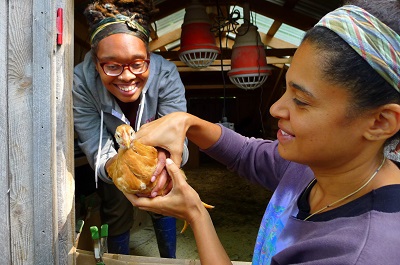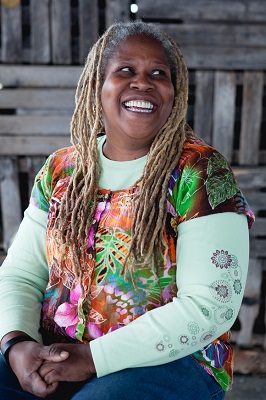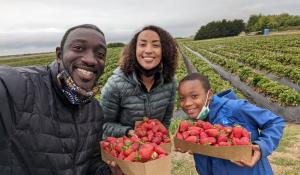
In Durham, North Carolina, a young man rakes a dirt path in between rows of leafy soybeans. In Alabama’s Black Belt, a woman rolls a feathery ball of cotton between in her fingers, inspecting it for pests. In eastern Mississippi, an older woman, scissors in hand, kneels into a nest of leaves and uses a spade to harvest a sweet potato.
The year is 1910 and 14 percent of the nation’s farmers are Black Americans. Living before the times of widespread mechanization, their labor is physically intense and intimate with the earth. Purchased only two generations after emancipation, these plots of land represent the resilience and dignity of the communities they serve.
Since then, America’s agricultural landscape has changed, and not only where big machines have replaced hands and feet. Today, fewer than two percent of the nation’s farmers are African American, according to the 2017 USDA Census of Agriculture. What happened in the past 110 years are vital parts of our nation’s story in which seeds of innovation, regeneration, and communal stewardship are planted throughout.
The African Roots of Regenerative Agriculture
Conventional agriculture accounts for 23 percent of human-created greenhouse gas emissions. “Regenerative agriculture” is a set of practices for restoring soil health and maximizing the soil’s ability to draw down carbon from the atmosphere. Regenerative practices have gained popularity as more farmers recognize that dependence on pesticides, chemical fertilizers, and machinery robs the land of its natural organic matter.
But even members of the regenerative movement may not know that Black agriculturalists have long innovated in soil stewardship. In the 1890s, Dr. George Washington Carver developed a series of experiments proving that nitrogen-rich legume like peanuts could be used for more than a tasty spread, but also replenish soil when used in crop rotation. Centuries before Carver’s research, agriculturalists on the African continent sustained civilizations with regenerative techniques.
“Right now I’m working in a polyculture where we have blueberries, juneberries, apples, and medicinal herbs. This idea of growing a bunch of perennial crops together comes from different parts of sub-Saharan Africa,” says farmer Leah Penniman.
Penniman and her husband Jonah Vitale-Wolff founded the nonprofit Soul Fire Farm in 2010— an organization based in Grafton, New York, with a mission to end racism and injustice within the US food system.
“I’m also walking through rows of raised beds, which comes from Namibia’s Ovambo people who built mounds in order to control water flow and increase soil fertility,” says Penniman.
Penniman is part of a new generation of Black farmers using regenerative practices to pursue food justice and reverse climate change simultaneously. Soul Fire Farm provides immersive training to Black, Indigenous, Latinx, and other farmers of color. It also advocates for policies that expand access to crop and technical insurance, non-GMO seeds, guarantees living wages for farmworkers, and increases markets for farmers of color.

Seldom-Told Stories
Part of the reason why organizations like Soul Fire farm teach new generations of Black farmers about their ancestral roots in agriculture is many people still don’t know about this part of our country’s history.
After emancipation, Jim Crow laws enabled states to lock up Black people for petty crimes and returned previously enslaved people to plantations at correctional facilities. In the share-cropping system, Black farmers rented land and equipment from white owners who received a share of the Black farmer’s harvest with interest. Unaffordable interest rates led to perpetual debt for Black farmers, many of whom tried and failed to pay off their debts with their own free labor.
The experiences of Black farmers received little attention until recently, with investigative pieces like Vann R. Newkirk II’s “The Great Land Robbery” published in The Atlantic in September 2019 and Penniman’s book, Farming While Black. These writings detail the history of discrimination against Black farmers, including by USDA officials who routinely denied loans, technical assistance, and disaster relief funds to Black Farmers, especially to those who were active in the civil rights work.
In 1995, Virginia farmer Dr. John Boyd Jr. founded the National Black Farmers Association (NBFA) to help farmers hold on to their lands and increase access to public and private loans. In 1997, Boyd and 400 others successfully sued the USDA in the case Pigford v. Glickman, which confirmed that the USDA had turned a blind eye to hundreds of civil rights complaints filed by Black farmers, including Boyd, who had filed six complaints.
“All these farmers were coming out of the woodwork saying, ‘You think what happened to you is bad? You should hear my story!’” said Boyd in a 2019 interview with The Guardian. “I was just trying to save my farm. But then I saw this was a huge national issue.”
Pigford v. Glickman exposed the USDA but fell short of achieving justice. The government awarded $50,000 each to approximately 16,000 plaintiffs but there were many eligible farmers who didn’t know about the lawsuit’s application deadline. In 2010, the Obama administration re-opened the case and delivered more awards, but systemic racism and its effects still linger.
One of the NBFA’s newest projects is Regenerating Our Farms, which partners with organizations including the USDA, North Carolina State University, and Farmer’s Footprint to provide information and support to Black Farmers across North Carolina, South Carolina, and Virginia for adopting new soil health practices.
The Fight for Food Justice
The systemic denial of access to farming means that many African Americans and other people of color depend largely on retailers like grocery stores to get fresh foods, but too often retailers fail to show up in lower-income neighborhoods. Lack of access to healthy foods has had profound health effects, with 21.2 percent of Black households and 16.2 percent of Hispanic households experiencing food insecurity—the USDA’s measure for decreased access to healthy and varied food. Meanwhile, only 8.1 percent of white households are food insecure, according to 2018 USDA data.
Holes in food access go beyond hunger—a lack of fresh food exacerbates other health issues. According to 2019 CDC data, although obesity is a nationwide issue, Hispanic and Black adults are ten percent more likely be obese than white adults and experience diabetes at roughly double the rate of white adults.
Community organizer Karen Washington was first driven towards gardening as she sought to fix one of the trash-filled empty lots that had become a blight in her neighborhood.

“It was one of over 1,000 empty lots that were plaguing mostly low-income neighborhoods and neighbors of color in New York City,” Washington says. “And in 1988, with a group of people in the community, we were able to turn that empty lot into a community garden.”
In 2014, she co-founded Rise & Root Farm, an organization dedicated to promoting regenerative practices and increasing access to fresh produce. Washington considers it her responsibility to give Black farmers a space to recognize their role in the food supply. She co-founded Black Urban Growers, a group which brings Black farmers together to meet each other in an overwhelmingly white industry with annual conferences since 2009.
“In doing some research and looking at the census, finding out back in 2008, that of the 57,000 farmers in New York State, only 116 were Black. Fast forward that to now—57,000 farmers in New York State, still only 139 still are Black,” Washington says. “We have this conference every year where we bring people from all over this nation to come in and see a face, where it reflects who they are, and for them to have a buy-in in a system that for so long has negated them.”
The urban gardening and farming movement that has taken off in cities shaped by large Black communities like those in Chicago, Baltimore, and Newark, show that empowering people to grow their own food can be part of the solution.
“I grew up detached from the food movement, because as an African American, my relationship to food was always around the narrative of slavery,” says Washington, who is now one of Penniman’s mentors. “We’re now telling young Black and Brown people in urban and rural areas that their connection to food is powerful and that we do have a place in agriculture.”
How You Can Join The Fight For Food Justice
1. Support non-profit organizations that are investing in Black farmers like Soul Fire Farm, National Black Farmers Association, National Black Food and Justice Alliance, Black Urban Growers, and Rise and Root Farm. You can donate, volunteer time, and/or share their work on social media.
2. Call on your Congresspeople to support progressive legislation like the Justice For Black Farmers Act, Fairness for Farmworkers Act of 2019, Urban Agriculture Act of 2016, and the North American Agricultural Work Visa.
3. Buy from Black farmers at farmers markets and Community Supported Agriculture (CSA) programs.
4. When possible, buy products that are Food Justice Certified with the Agricultural Justice Project. This certification addresses fair wages for farmworkers, fair pricing for farmers, safe and healthy working conditions, the rights of indigenous people and children on farms.







